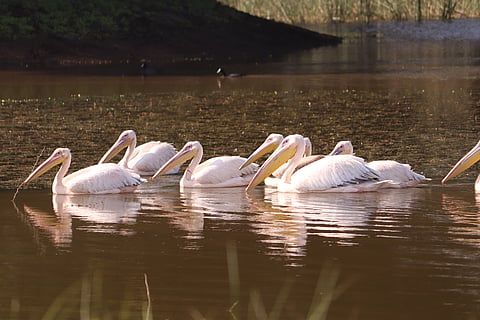
- Destinations
- Experiences
- Stay
- What's new
- Editor’s Picks
- Responsible Tourism
- CampaignsCampaigns
- Subscribe

If you’re craving a break from the constant notifications and stresses of digital and city life, and if you can get away from it all, even for a little while, then the more-than-human world is your antidote. Spending time in nature with creatures big and small has been shown to reduce stress, improve wellbeing and inspire awe, among plenty of other benefits. One of these places is the Khijadiya Bird Sanctuary, home to more than 220 species of birds, including pelicans, flamingoes, spoonbills, ducks, egrets and herons. Located near Jamnagar, Gujarat, the sanctuary is spread over 605 hectares of marshy wetlands and mangroves, providing shelter to a wide range of migratory and resident birds.
So, pack your binoculars, a field guide and other essentials for a birdwatching trip, and check out what you can expect from a holiday at the Khijadiya Bird Sanctuary.
The Khijadiya Bird Sanctuary on the south coast of the Gulf of Kutch has a combination of seasonal freshwater lakes, intertidal mudflats, creeks, salt pans, saline land and mangrove scrubs. This hodgepodge of different ecosystems came about when a check dam was built to store the waters of the river Ruparel just before it entered the sea. Called bunds, they arrested freshwater from draining into the sea and stopped the salinity ingress from the seaside. Over the years, with the freshwater of the rain and river on one side and the saltwater of the sea on the other side, a unique area was formed.
This area was designated as a sanctuary in 1981 and a “wetland of international importance” under the Ramsar Convention in 2022. As one of the important waterbird habitats of northwest India, the site provides breeding, feeding and roosting grounds for a wide range of resident aquatic and land-based birds. It is the habitat of nearly 125 waterbirds, of which over 165,000 individual waterbirds have been counted. These include the endangered Pallas’s fish-eagle, Indian skimmer and the vulnerable common pochard. The sanctuary also supports more than one per cent of the south and southwest Asian population of Dalmatian pelican, more than two per cent of the greylag goose and more than 20 per cent of the common crane.
The variety of birds and mammals which inhabit this landscape is astounding. A visit here means you are likely to see great crested grebes, little grebes, purple moorhens, coots, black-winged stilts, ospreys, pheasant-tailed jacanas, painted storks, cormorants, terns, gulls, kingfishers, harriers, hawks, falcons, the globally threatened black-necked stork, and migratory swallows, martins, and wagtails. Jungle cats, foxes, nilgai and mongoose can be found in the shrubland. It is also not unusual to come across freshwater turtles.
The flora here is no less amazing. More than 180 plant species have been recorded, including the critically endangered Indian bdellium-tree. There is emergent aquatic vegetation growing above the surface of the shallow waters of the lake, that primarily include the narrow-leaved cattail, sedges and sugarcane. Floating and underwater aquatic plants include the Hydrilla verticellata, tape grass and brittle water nymph. Non-aquatic species like karira and babul naturally occur in the area. The Avicennia marina, commonly known as grey or white mangrove, occurs in the adjoining marine sanctuary.
In addition to all this, the Khijadiya Bird Sanctuary contributes to the maintenance of hydrological regimes, erosion protection and nutrient cycling.
Today, the sanctuary functions as an ecotourism site, drawing scientists, nature lovers, birdwatchers and more. Visitors can enjoy the tranquil atmosphere of the sanctuary while walking along its well-maintained nature trails, watching birds in their natural habitat and capturing some amazing photographs. The best time to visit the Khijadiya Bird Sanctuary is from October to March when migratory birds add to the chorus of wildlife.
Take the train to Jamnagar Railway Station (JAM) or Jamnagar Airport (JGA). The Khijadiya Bird Sanctuary is 15-20 kilometres from there by taxi. You can consider a bus or taxi to the sanctuary from Rajkot (82 kilometres) and Ahmedabad (296 kilometres), too.
